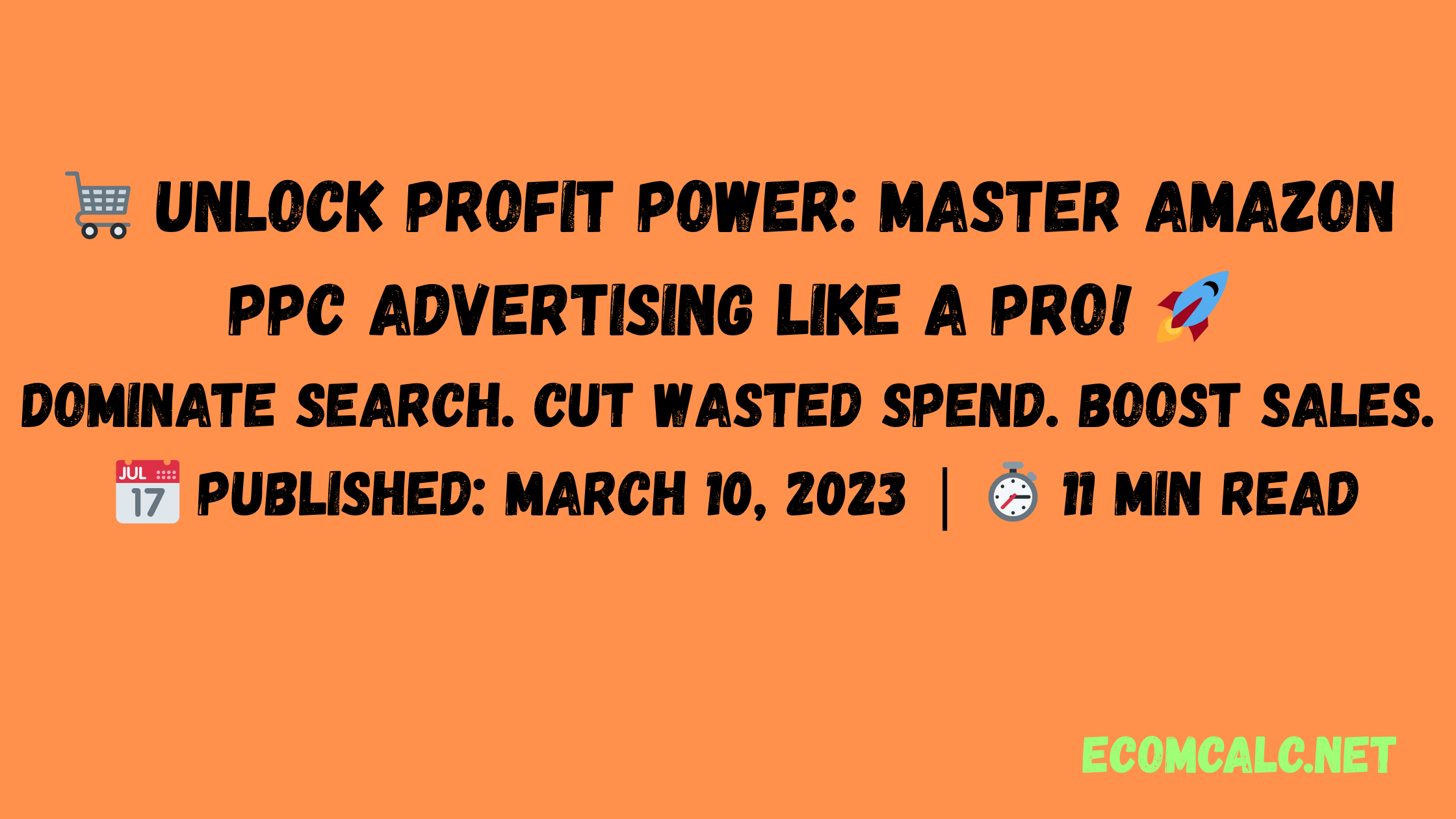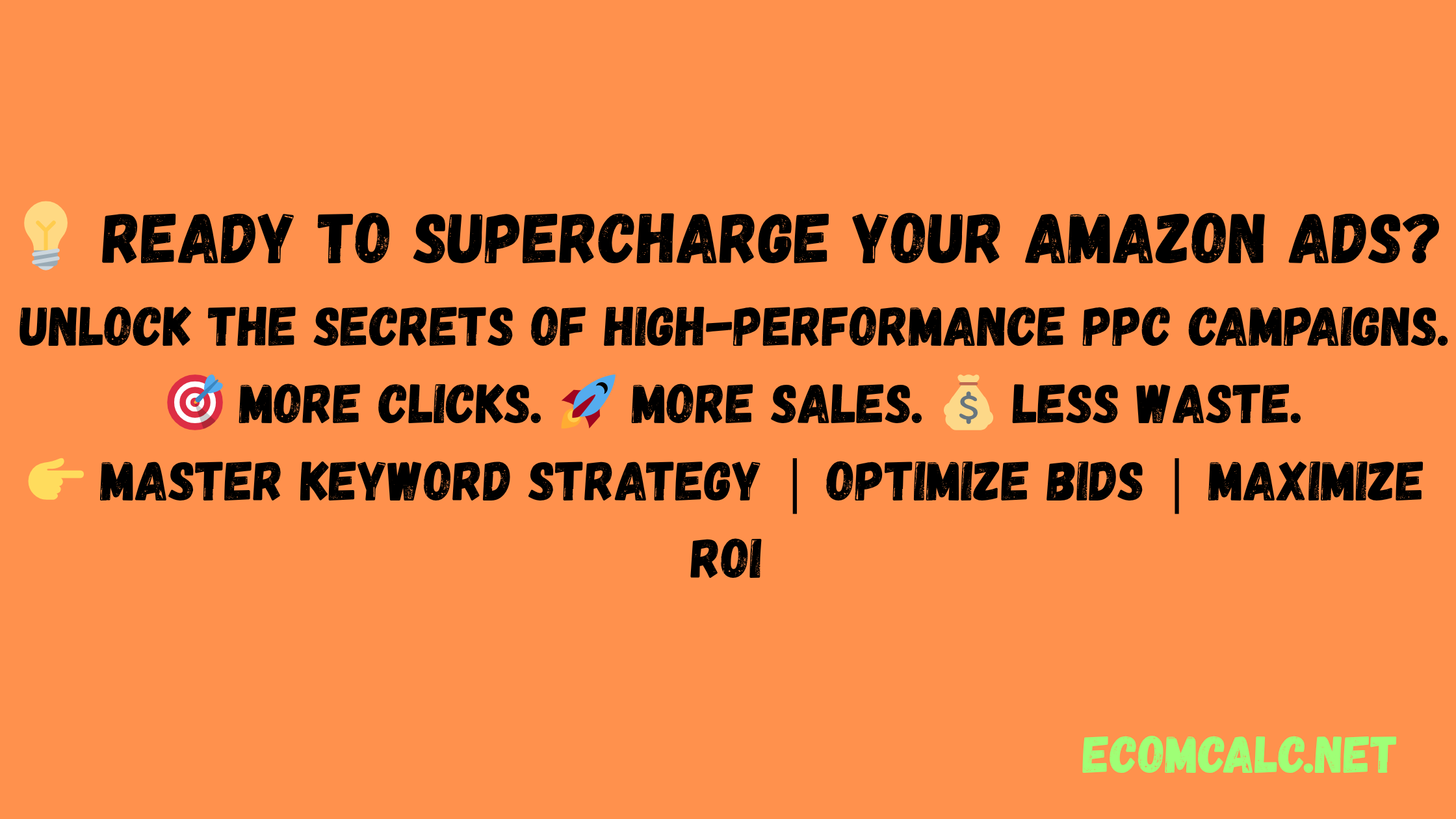Amazon PPC Advertising: How to Optimize Your Campaigns
Published on March 10, 2023 | 11 min read
Amazon is more than just the world's largest online marketplace—it's a thriving digital advertising platform. With millions of sellers and billions of product listings, standing out requires more than a great product and a polished listing. That’s where Amazon Pay-Per-Click (PPC) Advertising steps in.
But running a PPC campaign isn’t just about throwing money at Amazon and hoping for clicks. To truly scale your business and maintain profitability, you need strategic planning, continuous optimization, and a firm grip on performance metrics.
In this guide, we’ll break down how to optimize your Amazon PPC campaigns to increase visibility, boost sales, and control costs.

1. Understanding Amazon PPC: The Basics
Amazon PPC is a system where sellers pay for ad placements on Amazon. You bid on keywords, and when shoppers search for those keywords, your ads may appear. You only pay when someone clicks.
There are three main types of Amazon PPC ads:
- Sponsored Products – Promote individual product listings.
- Sponsored Brands – Showcase your brand and multiple products.
- Sponsored Display – Target shoppers on and off Amazon.
Each ad type has its own purpose, targeting capabilities, and placement. For most sellers, Sponsored Products offer the best starting point due to their direct ROI and strong visibility.
2. Structuring Your Campaigns for Success
Campaign structure might sound boring, but it’s the backbone of optimization.
a. Group by Product Category
Keep similar products in the same campaign. Selling kitchen tools and beauty products? Don’t mix them. Separate campaigns make performance tracking and optimization easier.
b. Segment by Match Type
Amazon offers three match types:
- Exact Match: Ads show only for the exact keyword.
- Phrase Match: Ads show for queries containing your keyword in the right order.
- Broad Match: Ads show for loosely related queries.
Split these into different campaigns or ad groups to control bidding and monitor performance more accurately.
c. One ASIN per Ad Group (if possible)
This gives you more granular control over keyword performance per product, preventing budget drain by underperforming ASINs.
3. Keyword Strategy: Laying the Groundwork
a. Start with Exact Match
When launching a new product, go for precision. Exact match keywords help you control spend and collect high-quality data quickly.
b. Expand with Phrase and Broad
As you collect performance data, scale by testing phrase and broad match keywords. These uncover additional search terms customers use, which may not have been in your initial list.
c. Use Amazon’s Auto Campaigns (Strategically)
Automatic campaigns can discover unexpected converting terms. Run them alongside your manual campaigns, and mine them for winning keywords to transfer to manual exact match campaigns.
4. Mastering Negative Keywords
Think of negative keywords as your cost-saving tool. Without them, your ads might show for irrelevant searches, draining your budget.
a. Regularly Mine Search Term Reports
Download these weekly. Look for high-spend, low-conversion (or no-conversion) terms. Add them as negatives.

b. Use Campaign-Level Negatives
Block irrelevant terms across campaigns. For example, if you’re selling luxury watches, exclude terms like "cheap watches" or "watch straps."
c. Don’t Forget Phrase and Broad Negatives
Negative phrase match prevents your ad from showing when that specific phrase appears in the search term. Use this to tighten your targeting further.
5. Smart Bidding: Adjust for Profit
a. Start Conservative
Launch campaigns with moderate bids. Once you see conversion data, adjust accordingly.
b. Increase Bids for High-Performers
If a keyword is converting well and generating profitable sales, increase the bid to gain more impressions.
c. Lower or Pause Poor Performers
If a keyword is spending heavily without conversions, reduce the bid or pause it entirely.
d. Use Dynamic Bidding (Down Only)
This lets Amazon lower your bid when a conversion is less likely, protecting your budget.
6. ACoS: The North Star Metric
ACoS (Advertising Cost of Sale) = (Ad Spend / Attributed Sales) x 100
a. Determine Your Break-Even ACoS
Know your profit margins. If your product’s profit margin is 30%, your target ACoS should be below 30% to remain profitable.
b. Optimize Towards ACoS Goals
- Launch Phase: Accept higher ACoS as you gather data.
- Growth Phase: Aim for break-even or slightly lower ACoS.
- Profit Phase: Cut low performers and optimize to drive ACoS down.
7. Budgeting Wisely
a. Allocate More to Bestsellers
Bestselling products with strong organic rankings often yield better returns. Invest more where you see results.
b. Don’t Spread Too Thin
Running 20 campaigns on a $50 budget? Not a good idea. Focus on a handful of high-potential campaigns and scale as your revenue grows.
c. Daily Budgets Should Reflect CPCs
If your average CPC is $1.50, a $5/day budget means just 3 clicks/day. Budget accordingly to get meaningful data.
8. Optimizing for Placement
a. Analyze Placement Reports
See which placements bring in the most conversions. Adjust your placement modifiers accordingly.
b. Top of Search Can Be Gold
If your top-of-search ads convert well, increase placement bid adjustments to capture more premium traffic.

9. Using Amazon’s Tools
- Search Term Reports – See which customer searches triggered your ads and how they performed.
- Targeting Reports – Analyze which specific targets (keywords, ASINs) drive your results.
- Budget Report – Avoid missed impressions due to budget limits by tracking budget usage.
10. Leveraging Software and Automation
a. Use PPC Management Tools
Tools like Helium 10, Jungle Scout, Sellics, and Perpetua can automate keyword harvesting and bid adjustments.
b. Set Rules for Automation
Example: “If ACoS > 60% for 7 days, reduce bid by 15%.” This maintains control while automating decisions.
c. Monitor Closely
Automation is a helper, not a replacement for strategy. Always review results manually each week.
11. Product Listing Optimization
a. Optimize Titles and Bullet Points
Ensure your title is keyword-rich but readable. Bullet points should highlight features, benefits, and customer pain points.
b. Use High-Quality Images
Invest in professional photos that showcase your product’s quality, usage, and scale.
c. Improve Reviews and Ratings
Use Amazon’s “Request a Review” button and consider programs like Vine to increase reviews.
12. Tracking, Testing, and Scaling
a. Track Key Metrics Weekly
Watch ACoS, CTR, CPC, and CVR. These will tell you what to scale or stop.
b. Run A/B Tests
Test different ad types, keywords, headlines, and images to find what converts best.
c. Scale What Works
Raise budgets, duplicate high-performing campaigns, and apply winning structures to similar products.
13. Common Mistakes to Avoid
- ❌ Setting and Forgetting
- ❌ Ignoring Mobile Traffic
- ❌ Bidding Too Low
14. Final Thoughts: Stay Agile, Stay Smart
Amazon PPC isn’t just a switch to turn on—it’s a living system that requires ongoing attention, testing, and refining. The competition is stiff, and CPCs continue to rise. But with a strong campaign structure, smart bidding strategies, and constant optimization, Amazon PPC can become your most powerful growth lever.
Remember:
- Start narrow, scale smart.
- Data beats gut feeling.
- Profitability is the real win—not just impressions or clicks.
Bonus Resources
- Amazon Ads Learning Console
- Free ACoS Calculator (Google Sheets)
- Weekly PPC Audit Checklist Template